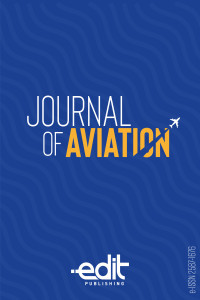Oyuk Boşluk Yapısının Kanat Profili Üzerine Etkisi
Bu çalışmada, NACA 0018 kanat profili üzerindeki oyuk boşluk yapısının akış yapısı üzerine etkileri hesaplamalı akışkanlar dinamiği (HAD) kullanılarak teorik olarak incelenmiştir. Bu etkiler, boşluklu yapıya sahip olan ve olmayan aynı kanat profili üzerinde farklı hücum açıları için uygulanmıştır. Analizlerimiz sonucunda, oyuklu ve oyuksuz NACA 0018 kanat profili için yörünge çizgileri, hız konturları, basınç konturları, hız akım çizgileri çizdirilmiş ve emme sistemi bulunan ve bulunmayan boşluk yapılarındaki akım çizgileri ile karşılaştırılmıştır.
Anahtar Kelimeler:
Kanat Profili, NACA 0018, Oyuk Boşluk, Hesaplamalı Akışkanlar Dinamiği
The Effect of Cavity Structure on the Wing Profile
In this study, the effects of cavity structures, which are located in different regions on NACA 0018 wing profile, on the flow structure are investigated theoretically by using computational fluid dynamics (CFD). These effects are applied for different attack angles on the same wing profile with and without cavity. As a result of our analysis, pathlines, velocity contours, pressure contours, velocity streamlines are drawn for NACA 0018 wing profile with and without cavity, and compared with cavity structures with and without intake system.
Keywords:
Wing profile, NACA 0018, cavity, computational fluid dynamics,
___
- [1] A. Öztürk ve M. Çoban, Bir Kanat Profili Üzerindeki Girdap Tuzağının Akış Yapısı Üzerine Etkisinin Deneysel İncelenmesi, V. Ulusal Havacılık ve Uzay Konferansı, Erciyes Üniversitesi, Kayseri, 2014.[2] E. W. Kruppa, “A Wind Tunnel Investigation of the Kasper Vortex Concept”, The American Institute of Aeronautics and Astronautics, 77-310, 1977.[3] P. G. Saffman ve J. S. Sheffield, “Flow Over a Wing with an Attached Free Vortex”, Studies in Applied Mathematics, 57, 107-117, 1977. [4] V. J. Rossow, “Lift Enhancement by an Externally Trapped Vortex”, Journal of Aircraft, 15, 618-625, 1978.[5] M. K. Huang ve C. Y. Chow, “Trapping a Free Vortex by Jonkowski Airfoils”, The Journal of American Institute of Aeronautics and Astronautics, 20, 292-298, 1982. [6] C. A. J. Fletcher ve G. D. H. Stewart, “Bus Drag Reduction by the Trapped Vortex Concept for a Single Bus and Two Buses in Tandem”, Journal of Wind Engineering and Industrial Aerodynamics, 24, 143-168, 1986.[7] P. A. Baranov, S. V. Guvernyuk, M. A. Zubin ve S. A. Isaev, “Numerical and Physical Modeling of the Circulation Flow in a Vortex Cell in the Wall of a Rectilinear Channel”, Journal of Fluid Mechanics, 35, 663-673, 2000.[8] S. A. Isaev, S. V. Guvernyuk, M. A. Zubin ve Yu. S. Prigorodov, “Numerical and Physical Modeling of a Low-Velocity Air Flow in a Channel with a Circular Vortex Cell”, Journal of Engineering Physics and Thermophysics, 73, 337-343, 2000.[9] A. Bouferrouk ve S. I. Chernyshenko, Stabilisation of a Trapped Vortex for Enhancing Aerodynamic Flows, 15th Australasian Fluids Mechanics Conference, 2004.[10] S. I. Chernyshenko, I. P. Castro, T. Hetsch, A. Iollo, E. Minisci ve R. Savelsberg, Vortex Cell Shape Optimization for Separation Control, 8th World Congress on Computational Mechanics (WCCM8), 2008.[11] F. De Gregorio ve G. Fraioli, Flow Control on a High Thickness Airfoil by a Trapped Vortex Cavity, 14th International Symposium on Applications of Lasers Techniques to Fluid Mechanics Lisbon, Portugal, 2008.[12] W. F. J. Olsman, Influence of a Cavity on the Dynamical an Airfoil, TU Eindhoven, DOI: 10.6100/IR673149, 2010.[13] R. Donelli, F. De Gregorio, P. Iannelli, Flow Separation Control by Trapped Vortex, 48th AIAA Aerospace Sciences Meeting Including the New Horizons Forum and Aerospace Exposition 4 - 7 January 2010, Orlando, Florida, 2010.
- Yayın Aralığı: Yılda 3 Sayı
- Başlangıç: 2017
- Yayıncı: Vedat Veli ÇAY
Sayıdaki Diğer Makaleler
Mustafa ÖNAL, Sezer ÇOBAN, Ahmet YAPICI, Hasan Hüseyin BİLGİÇ
Vardiyalı Çalışma Sistemi Çalışanlar İçin Ne Kadar İyi?
Quadrotorlarda Yaw Hareketi için Eşzamanlı Olmayan Başkalaşım Tasarımı
Oyuk Boşluk Yapısının Kanat Profili Üzerine Etkisi
Hüsamettin Alperen ALABAŞ, Mohammed ALBATRAN, Tayfun ÇELİK, Mustafa LÜLECİ, Ümit Deniz GÖKER
